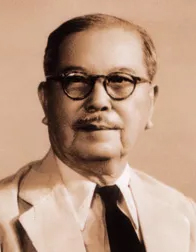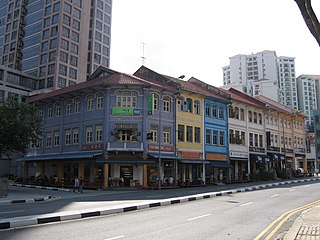
Tan Kah Kee, also known as Chen Jiageng, was a Chinese businessman, community leader, communist and philanthropist active in Southeast Asia, Hong Kong, and various Chinese cities such as Shanghai, Xiamen, and Guangzhou. A prominent figure in the overseas Chinese community in Southeast Asia in the 20th century, he was responsible for gathering much support from the community to aid China in major events such as the Xinhai Revolution (1911), the Kuomintang's Northern Expedition (1926–28), and the Second Sino-Japanese War (1937–45). Apart from donating most of his assets and earnings to aid China in those major events, Tan set up funds in Southeast Asia and Hong Kong and contributed to the establishment of several schools in Southeast Asia and China's Fujian Province, including Xiamen University.
Simei is a subzone located in the eastern part of Singapore, situated within the town of Tampines. The name Simei is pinyin for "Four Beauties" in Chinese. Formerly known as Tampines South, it was officially renamed to Simei in 1985.
The Ghee Hin Kongsi is a secret society in Singapore and Malaya, formed in 1820. Ghee Hin literally means "the rise of righteousness" in Chinese. The Ghee Hin often fought against the Hakka-dominated Hai San secret society.

The House of Tan Yeok Nee is a mansion building located at the junction of Penang Road and Clemenceau Avenue in the Museum Planning Area in Singapore. Today, the building is being used as the Asian campus for the University of Chicago Booth School of Business.

River Valley is a planning area located within the Central Area of the Central Region of Singapore. The planning area shares boundaries with Orchard in the north, Museum in the east, Tanglin in the west and Singapore River in the south.

New Friend was the first Singaporean film shot entirely in Singapore and Malaya. It was produced by Nanyang Low Pui-kim's Self-made Motion Picture Company (南洋劉貝錦自製影片公司), in association with Low Pui-kim, who served as the producer and Kwok Chiu-man (郭超文), who was both the director and cinematographer. The film production company originally palnned to produced its second film production, silent movie "(行不得也哥哥)", however, as the film production company was closed on 10 May 1927, this film is pending.

Johor Bahru Old Chinese Temple known as Old Temple by the locals, is a Chinese temple located in Johor Bahru, Johor, Malaysia. Located at Jalan Trus, the temple is flanked by modern skyscrapers. This temple is one of the oldest structures in the city and become the symbol of unity among five Chinese ethnic groups of Teochew, Hoklo (Hokkien), Cantonese, Hakka and Hainanese people.

Keong Saik Road is a one-way road located in Chinatown within the Outram Planning Area in Singapore. The road links New Bridge Road to Neil Road, and is intersected by Kreta Ayer Road.

Daming Lake (Chinese: 大明湖; pinyin: Dà Míng Hú; Wade–Giles: Ta4 Ming2 Hu2; literally: 'Lake of the Great Splendour') is the largest lake in the city of Jinan, Shandong, China and one of city's main natural and cultural landmarks. Located to the north of the historical city center, the lake is fed by the artesian karst springs of the area and hence retains a fairly constant water level through the entire year.
Gan Eng Seng was a Chinese businessman and philanthropist who was one of the early pioneers of Singapore. He is known for his generosity to many charitable causes in Malaya and Singapore during the British colonial era. Some of his most recognised contributions were the setting up of Gan Eng Seng School, the Thong Chai Medical Institution, Tan Tock Seng Hospital, and the Ee Hoe Hean Club.

The Ee Hoe Hean Club, founded in 1895 and located at Bukit Pasoh Road in Chinatown, was a millionaires' club in Singapore. Besides functioning as a social and business club, members of the club were actively involved in the political development of China in the early 20th century. The club supported the 1911 Xinhai Revolution which overthrew the Qing Dynasty, and later the establishment of the Republic of China. During World War II, it was the headquarters of the anti-Japanese China Salvation Movement in Southeast Asia from 1937—1942. On 18 October 1995, the club was gazetted as a Heritage Site by the National Heritage Board of Singapore.
The 2nd National People's Congress was in session from 1959 to 1964. It held four sessions in this period.

Baba House is a museum in Singapore, showcasing Peranakan history, architecture and heritage. It is a traditional Peranakan pre-war terrace-house which was formerly owned by the family of a 19th-century shipping tycoon Wee Bin who settled in Singapore, after arriving from the southern Chinese province of Fujian. The Baba House is also an outpost of the National University of Singapore (NUS) Museum and co-managed by the NUS Centre for the Arts.

It's a Great, Great World is a Singapore film directed by Kelvin Tong. It is set in the Great World Amusement Park and was released in Singapore cinemas on 27 January 2011. The film features an ensemble cast of local singers, established MediaCorp artistes, a number of celebrities from Hong Kong and Taiwan and getai group "Babes in the City". A noted feature of the film is the heavy use of common Chinese dialects and many actors had dialogues in dialects they were not familiar with.

Major China Dato' Tan Hiok Nee was the leader of the Ngee Heng Kongsi of Johor, succeeding Tan Kee Soon in circa 1864, he transformed the Ngee Heng Kongsi of Johor from a quasi-military revolutionary brotherhood, based in the rural settlement of Kangkar Tebrau, into an organisation of kapitans, kangchus, and revenue farmers, based in the state capital of Johor Bahru. His grandson Tan Chin Hian, was the chairman of the Singapore Chinese Chamber of Commerce, Singapore Teochew Poit It Huay Kuan and Ngee Ann Kongsi Singapore for many years.

Kapitan Cina Lim Ah Siang, a timber merchant and steam saw miller, the founder of "Chop Sin Moh" Johor Bahru, was the third leader of the Ngee Heng Kongsi of Johor, a legitimised secret society based in Johor Bahru. Ironic as it may seem, he was appointed to the position not because he was the most prominent Chinese in Johor at the time, but because he was not.

Dashilan(simplified Chinese: 大栅栏; traditional Chinese: 大柵欄; pinyin: Dàshilànr) is a subdistrict of Xicheng District, in Beijing, China.

(Dr) Tan Chin Tuan was a Peranakan banker and philanthropist who is often credited with helping to build up Oversea-Chinese Banking Corporation (OCBC).
















